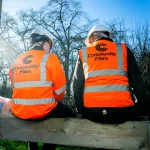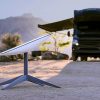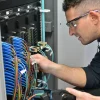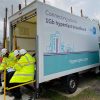Early SpaceX Starlink LEO Broadband Speedtests Disappoint

The original promise of “fibre-like” broadband speeds from SpaceX’s future mega constellation of small Low Earth Orbit (LEO) Starlink satellites may not materialise. A leak of early speedtests from beta customers in the USA point to “superfast” (30Mbps+), but not “ultrafast” (100Mbps+), levels of performance. Fine.. but not “fibre“.
The LEO platforms weigh around 150-260Kg each and, with solar panels folded, are often smaller than an adult while orbiting at around 500-1300km above the Earth, which is significantly nearer than their giant double-decker bus sized satellite cousins in geostationary orbit (GEO / GSO) at c.35,000km. As a result of this such satellites should be able to achieve significantly faster latency times of 25-40ms and SpaceX has previously hinted at “1Gbps” and “fibre-like” broadband speeds being a possibility.
The downside of this approach, when compared with the double decker bus sized GSOs of old, is that you need an awful lot of LEO satellites to achieve global coverage. At present SpaceX’s Starlink project has already launched hundreds of LEO satellites and they have an ambition to deploy 4,425 by 2024 (possibly followed by 10,000+ at a later date).
Advertisement
Assuming all goes to plan then they’ll shortly have enough (800 LEOs) for partial global coverage and an early commercial launch by the end of this year or early 2021 seems likely, albeit not reaching the UK for awhile. Last month we also got our first glimpse of the beta setup for the new service and its terminals (here), but now we’re also starting to see examples from early speedtests and they’re.. fine, but nothing impressive.
Once again the leak comes from Reddit, which has seen community members trawl through data from Ookla’s popular Speedtest.net service in order to identify some of the first Starlink based speed testing results. Overall, those highly tentative results point to download speeds with a range of around 30Mbps to 60Mbps and uploads on 5Mbps to 18Mbps (roughly akin to real-world FTTC performance on Openreach in the UK).
Better news is the fact that latency times are coming in at between a low 20ms (this is what Elon Musk was targeting) and a rare high of 94ms (most tend to be 30-50ms), which is a massive improvement on the larger satellites of old (600ms to 2000ms).
Crucially though, we don’t know how much variance there is in such timings and if you’re at the upper end of that range (94ms) then fast paced online multiplayer gaming won’t be much fun, but 30-50ms is just about acceptable for such things.
Advertisement
At this point we have to give the usual caveat about this being an early beta test from the USA (mostly via users in Seattle and Los Angeles) and we know very little about SpaceX’s active network setup for the trial (e.g. active spectrum use and ground station utilisation both being key considerations). Suffice to say that we may see speeds go up or even down as the beta progresses. Nevertheless, we were hoping for “ultrafast” levels of performance from these, but once again reality and marketing hype can be two different things.
On the other hand, if you’re stuck in a rural area with significantly slower performance then all of this may still be considered good news, depending of course on how much it all ends up costing. One other group that might be breathing a sigh of mild relief could be the GSO/GEO satellite operators, which are busy preparing for 100Mbps+ speed plans in the very near future, albeit at much slower latencies.
Mark is a professional technology writer, IT consultant and computer engineer from Dorset (England), he also founded ISPreview in 1999 and enjoys analysing the latest telecoms and broadband developments. Find me on X (Twitter), Mastodon, Facebook, BlueSky, Threads.net and Linkedin.
« Next Generation 30Gbps Wi-Fi 7 Standard 802.11be Takes Shape
London UK Team Achieves Record 178Tbps Single Fibre Speed »























































So, let me get this right, the initial beta test of a system that’s barely begun to be built, off a bunch of unverified speedtest results, is already offering better speed and latency than most of rural UK can currently get.
But apparently this disappoints?
I would have killed for these speeds in the 8 years I lived barely off a main road in “rural” sussex.
Sorry, but I find the tone of this article a bit silly.
SpaceX has a pretty impressive history of delivering on their promises. Given what they’ve been up to just in the last couple of months if they say they’re going to deliver gigabit speeds from starlink my money is on them doing it.
Maybe we should wait til they’ve actually built it before critiquing it.
I hope you’re right, although I think given the technical specs of these spacecraft we can probably rule out “gigabit” speeds for consumers as being viable to the mass market. We’ll see how much better it gets from here, if at all.
uh-oh. upset the Elon musk worshippers. thank god it isn’t reddit. For some reason his rabid fandom are unable to accept any critique of him or any of his companies. Now where’s my hyperloop ticket I feel like a trip to fantasy land.
Not a bit silly at all,
When you’re presenting your new product and say it’s going to do XYZ and it achieves a fraction of that in initial user testing thats a fail, possibly only in a a short term publicity sense.
“Maybe we should wait till they’ve actually built it before critiquing it.” bear in mind these aren’t some kind of prototype build these are the deployed Units, Built what ? The entire global mesh ?
While the global mesh may well have ‘barely begun to be built’ as you put it, Over 500 functioning satellites are in orbit. If those aren’t generating the planned speed, covering a wider area with more isn’t going to improve that it’ll just give a wider area access to the same performance.
As Mark says we don’t know in what circumstances these tests were carried out, they could have been edge of coverage connections, which would put a different slant on the numbers entirely.
They claim to be generating multiple Terabytes a day in testing, but are as ever short with detail. If thats using all 500 units then that’s barely 10Gb each a day, but they’re not geostationary so can’t be running a solid 24 hours (unless they’ve managed to ring the globe with base stations) so we don’t know in what time period they achieved that.
I’d be very surprised if this is the limit of the system, I would also have loved these speeds and for longer than 8 years, but this tech wasn’t an option then and today its competing with Fibre, 5G and Docsis3.1 so if it’s not actually competitive it’ll be ignored in the countries and areas where better is possible.
I literally live on the side of a road – in a layby in a motorhome and I have a data sat dish.. I’d love to get a connection let alone these speeds. 4G is horrible here.
I’m quite surprised also, based on this (https://mobile.twitter.com/SpaceX/status/1253042868270149632) and other tweets it’s been very clear for a long time starlink isn’t an alternative to the high speed internet connections most of us have at the moment, it’s for those that are relying on marginal 4g connections or community WiFi services etc, it’ll never compete with FTTH. I think those download speeds and latencies are impressive compared to any other options in the middle of nowhere today.
So assuming we are at the lower end with speeds of 30Mbps, that is still better than anywhere in the UK that isn’t a main city. How is this a disappointment? This is good news for 80% of the Country and if you do happen to live in a big city with speeds faster than this then why are you here hoping for faster speeds when you already have ultra fast speeds?
You guys are over your head. Starlink isn’t supposed to help you with faster internet outside of cities, it is target at MOST rural-semi rural areas, 3 to 5 percent of population per Musk word. He may have said that have USA in mind, rural percentage in Europe is much lower then in North America.
@John Smith
“So assuming we are at the lower end with speeds of 30Mbps, that is still better than anywhere in the UK that isn’t a main city”
Thankfully you’re misinformed. Most premises in the country can in fact access fixed broadband download speeds of more than 30Mbps (just over 96.4% according to the latest stats on Think Broadband), which obviously includes most rural premises. If you’re interested in a breakdown for urban, rural etc, Andrew at TBB helpfully publishes these on a regular basis.
People of the internet – stop arguing!
God, if that’s the case it’s a touch stupid sending anything into LEO when 4g (with a good backbone) is better!
How about this for an idea. Improve the mast-to-backbone bandwidth so everyone on every carrier can get “Ultra-fast”, will solve the issue at a mere fraction of the cost of sending satellites into orbit. Will also need doing before 5g becomes the norm.
Or why not allow people to try and invert instead of just throwing money at the existing infrastructure that is currently controlled by people that really dont want to spend any more money.
SpaceX/Elon isn’t hurting anyone by trying create a new (possibly better way) of having a globally (possibly interplanetary) connected internet! This isn’t the governments or tax payers money paying for this… its Elon/Investors/SpaceX.
I personally think a solution that combined both Satellite and ground based 4g/5g/6g++ is the best solution…no more roaming chargers…Just seamless connectivity (including on a plane or in the middle of the ocean)
I suspect that we may be missing the point of these initial Starlink configurations. The objective is to demonstrate LOW LATENCY – not MASSIVE BIRATES!
Any mobile radio engineer will tell you that it is possible to trade off between the 3 axis of SPEED vs POWER/RANGE/BATTERY LIFE vs LATENCY. In this case the power axis is fixed – so improvements in LATENCY will be achieved at the expense of SPEED.
In the high pressure world of High Frequency Trading it is not necessary to have huge bandwidths; low latency is much more important!
Just look at who is bankrolling this phase of Starlink and all will become a little clearer@
Okay so the backhaul is great. How about the congestion and conditions on the RF network between handset and mast?
@James
There isn’t a linear relationship between latency and speed.
Speed is a function of doing more in the same time span, latency is round trip time and is hugely affected by distance regardless of data rate. If you can’t send the next chunk until I tell you, you must wait ~the same time for my tiny message to get to you regardless of speed.
56kbs and 1gbs line rates will have the same minimum latency traversing the same distance. Higher speeds are achieved by doing more in the same time, typically lots more channels are used at higher bandwidths plus newer codecs use less time between bits.
What’s quicker at delivering data from 1000 1TB ssd’s over 1km a 10gbs line or a 2CV stuffed with the ssd’s?
“What’s quicker at delivering data from 1000 1TB ssd’s over 1km a 10gbs line or a 2CV stuffed with the ssd’s?”
It is very OT but this reminds me of something I did in another life time.
We had data to transfer from one DC to another DC over a long weekend. There was a dedicated fibre link set up to do the transfer from one array to another. It was a lot, lot slower than expected and nobody could really figure out why.
So, after a lot of messing around and scratching of beards we had to rapidly come up with another plan.
This involved asking a friend with a light aircraft to pick up a set of copied disks and fly them the length of the UK.
This *just* worked in time to get things back up on line for start of the working week.
This is what I was saying from the very beginning. Now, wait for more people to start using it and you will get 5Mbps down with 150ms ping latency. However may still be good for the desert in central Africa. Exactly the same happened to 4G (from 100Mbps+ announced) and the same will happen to 5G.
“ desert in central Africa”???? Which country is that desert at? Anything near the equator is a rainforest. Leave Africa alone, talk about the middle of Arizona or Navada please.
Kenya is near the equator and has a Desert (although technically east Africa)
Sahara desert is Northern Africa is huge so is a good example. So the guys georgrapht is bad,
“including on a plane or in the middle of the ocean” – exactly – at the moment I can’t get these speeds 2 miles from town so the potential to connect at these speeds anywhere in the world seems extraodinary.
You won’t get those speeds anywhere. Current and release version of Starlink requires grand station (connected to ground fiber network) in radius of few hundred kilometers around user. No ocean (unless you are close to coast but then what’s the point?) or plane use in that case.
Until there are more ground stations and satellites latency will be high as they may only be 550KM up but they may also 500KM horizontally from a ground station and a further 500KM horizontally from the user’s terminal. There is a live map at satellitemap.space
Ah, remembering the days when sat was 1 way and 56k was the uplink
I remember the day when Britannia Ruled the waves! After my best buddy and part-time lover Trump is reelected and I become PM, Britain and America will get married, and our baby Briterica will RULE THE WORLD! God bless Trump and me too!
Being a spacex fan, I was under the impression that all beta testers for starlink had to sign an NDA and not post anything related to starlink online.
I don’t think that it was overtly posted.
The data was scraped from SpeedTest data, according to the article which is publicly available by their API.
I don’t believe that there was anything in Starlink Beta T&C’s that tried to stop use of speed testing services as these are pretty essential…..
At the moment starlink is being built i wouldnt worry about test yet untill it becomes more established and consistent. However althought thise results are “disappointing” for some they are a great leap for half the planet.
One thing i am personally interested in is if this is just a kind of plug and go dish and a subscription and it truely will be a global internet system. What impact is that going to have on countries like china and North Korea?
Suddenly there citizens can get around there internet firewalls and this could be seen as a great threat to ghere government.
Can they not do this already if there are satellite beams that cover them?
I can’t see a dish being a good idea in North Korea: contraband. China it seems a bad idea too. There are ways around the censorship that don’t involve a dish visible from outside.
I think that things will improve on the speed side as they get more Sat’s overhead at any one time. They’re not even half way to their initial commercial service requirements in terms of sat launches and they only started launching this year. Also this is just the initial version of the satellites which I expect will be de-orbited in the coming years for the satellites which will actually form a global satellite mesh network.
Good idea for a.all island nations like the Falklands and such who don’t have a undersea fibre connection i suppose.
This is an early generation of the StarLink satellites where the satellites communicate with their neighbours over microwave. The ultimate mode of inter-satellite communication is via optical (laser). They’re just using microwave at the moment as it’s “easy” and quick to put in place though at much lower bandwidth.
Laser was postponed (or maybe canceled looking at delay?) in favor of ground station, don’t get your hopes up for that inter satelite communications.
As telephone masts can communicate via microwaves, I am struggling to understand how satellites in orbit communicating the very same way thousands of stationary ground based masts work can provide any benefit whatsoever.
Surely carriers would be far better off spending far more on backbone bandwidth across the UK and investing in LTE-A and 5g instead of going down this route?
Guess the real reason is they don’t want to pay for backbone bandwidth eh?
Actually planned for later on this year; From the StarLink WikiPedia page from CNN 26th October 2019: Elon said [so it must be true 😉 ] “The 60 satellites that we already flew are capable of operations, but the next version will have upgraded technology. By late next year, we’ll be flying satellite with lasers that allow them to talk to each other in space and share data, which ensures customers will never lose service.”
Are you really basing this on nearly year old article from CNN? There won’t be any laser links this year, next year, maybe for next few years or none at all. Do you think Musk is building 30-40 ground station in USA alone so he can use laser links during this year?
@Buggerlugz
“Surely carriers would be far better off spending far more on backbone bandwidth across the UK”
What you suggest may make sense in the UK but doing that wouldn’t address the issue in Starlinks other target markets around that world and I’m not aware that any of the UK mobile networks are investing anything in Starlink at all so its not like by Starlink existing, it is preventing investment elsewhere.
Many in under served areas would argue the mobile network operators are not currently investing enough in their own land based infrastructure. With the introduction of a Starlink option, the mobile network operations will now have some competition they didn’t previously have and they’ll therefore be forced to improve to prevent losing some of their customers so that should still benefit the end consumer.
Starlink may cause operators to invest LESS in extreme rural areas. Overall Starlink isn’t a big rival seeing at it will be targeting 3 to 5 percent of population which have poor service or noone at all.
Whatever the speed, it’ll no-doubt exceed what’ll be provided by the Boris’ NoneWeb, if the white elephant is ever completed.
Marek wrote: “Are you really basing this on nearly year old article from CNN?”
It makes sense, incremental improvements rather than trying to build the final mega constellation.
Marek wrote: “There won’t be any laser links this year, next year, maybe for next few years or none at all.”
You must work for SpaceX as you know more than they seem to know. 😉
Marek wrote: “Do you think Musk is building 30-40 ground station in USA alone so he can use laser links during this year?”
They need downlink sites to connect to the hardwire network and the closer they are to the wired endpoint and the more there are distributed the better the available bandwidth and the lower the latency; space and light working in a vacuum vs. fibre.
Cheers… Clark
It seems I know more then you about technical limitations but hey keep being delusional, at least only you will be dissapointed.
Marek wrote: “It seems I know more then you about technical limitations but hey keep being delusional, at least only you will be dissapointed.”
Seriously, if my comments and references are technically deficient please let me know where? I can’t see any cracks in what StarLink is trying to achieve?
500 of a planned 12000 starlink sats have been launched. They’ve achieved speeds that exceed my fibre to the premises connection in a new built industrial unit. The lowest band is faster than my fibre to the box connection at home. The latency is below 100ms which is excellent, and much lower in most cases.
Costwise starlink is much cheaper to roll out than 4g to rural locations, single homes in the outback, small towns in the Scottish highlands, etc. Third world countries that don’t already have good infrastructure will hugely benefit from starlink also.
It’s daft to say a beta test of 4% of a rolled out network, using beta hardware missing key connectivity, is a disapointment. A key milestone was to demonstrate sub 100ms latency to give SpaceX eligibility for up to 16B in federal funding for rural broadband. Achieved!
Now, once you add laser links between sats, which will definitely happen, bandwidth skyrockets and international latency will be LOWER than any terrestrial based systems.
Once you roll out the additional 11500 sats the average distance from consumer to sat will be much lower, reducing latency, increasing bandwidth, etc.
I don’t find this article to be well researched or considered. 4% of a network, with beta hardware, is the fastest most advanced network of sats with the largest coverage of any broadband provider in the world…. I mean… not disappointed at all.
There is some beta hardware in there. However the rollout of the v1.1 satellites which are meant to include inter satellite data links is meant to rollout out/up in Oct at the earliest.
Your point about qualifying for the fcc grants is key. There is a lot of money on the table for that.
Personally I imagine inter satellite data communication will be left to customers willing to pay the most for the fastest links e.g. Trading platforms or where there isn’t a suitable ground station.
Anyway a lot of customers would be happy to get those speeds, however there is room for improvement of which I am sure there will be.
As my accountant says to me, he has a lot of clients in Wales, with barely any connectivity, who are expected to submit there records electronically, who would snap your arm off for 30mbps.
Lets hope the cost is decent. However very happy for the U.S.to beta test the initial network.
“Marek says:
August 17, 2020 at 7:27 am
You guys are over your head. Starlink isn’t supposed to help you with faster internet outside of cities, it is target at MOST rural-semi rural areas, 3 to 5 percent of population per Musk word. He may have said that have USA in mind, rural percentage in Europe is much lower then in North America.”
3 to 5%? So, Elon will put all these sattelites only for 3-5%? 🙂 Almost whole USA and Canada are rural.